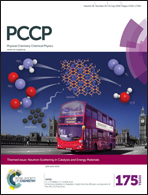Enhanced photoelectrochemical performance of quantum dot-sensitized TiO2 nanotube arrays with Al2O3 overcoating by atomic layer deposition†
Abstract
While TiO2 nanotube arrays cosensitized with CdS and PbS quantum dots can achieve water splitting under visible light excitation, the use of quantum dots is limited by the relatively slow interfacial hole transfer rate and low internal quantum efficiencies in the visible region. Al2O3 overcoating by atomic layer deposition (ALD) can drastically enhance the photoelectrochemical performance of the quantum dot-sensitized TiO2 nanotube arrays. 30 ALD cycles of the Al2O3 overlayer can achieve a good balance between surface coverage and charge transfer resistance. The resulting maximum photocurrent density of 5.19 mA cm-2 under simulated solar illumination shows a 52 times improvement over the pure TiO2 nanotube arrays, and more significantly, a 60% enhancement over bare quantum dot-sensitized TiO2 nanotube arrays. The incident photon-to-current conversion efficiency can reach the record value of 83% at 350 nm and remain above 30% up to 450 nm. A systematic examination of the role of the ALD Al2O3 overlayer indicates that surface recombination passivation, catalytic improvement in interfacial charge transfer kinetics, and chemical stabilization might synergistically enhance the photoelectrochemical performance in the visible region. These results provide a physical insight into the facile surface treatment, which could be applied to develop and optimize high-performance photoelectrodes for artificial photosynthesis.


 Please wait while we load your content...
Please wait while we load your content...